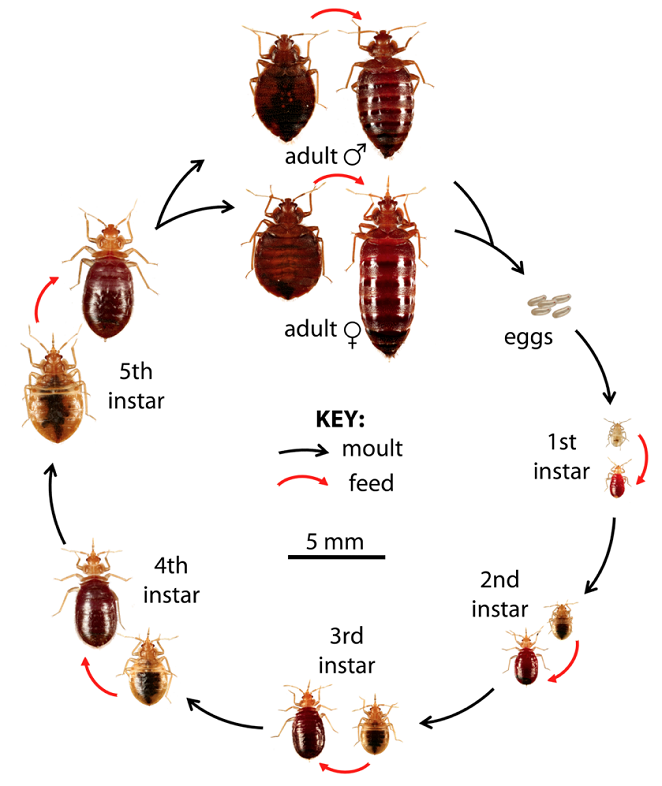
Adult bed bugs are flat, oval (similar in shape to a small apple seed), about 1/5” long, wingless, and rusty red or mahogany, once they have had a blood meal. Their bodies are flattened, and the males have a more rounded shape, while females are more slender in profile. Bed Bugs go through 5 nymphal stages and are very similar to adults, except the smaller size (1/20 –1/5 inch), and a pale-yellowish color. The five progressive stages require at least one blood feeding before molting to the next level. The entire cycle from egg to adult requires from five weeks to four months, depending on the availability of a blood feeding and temperature. The ideal temperature for rapid development is between 70° and 82°F.
Females lay two to five tiny (1/20 inch) white eggs per day close to their host’s resting places. They prefer rough natural surfaces like paper or wood, but will even lay on metal bed frames in heavy infestations. Bed Bugs lay 200 to 500 eggs in their life. A sticky coating covers the eggs, and at room temperature will hatch in about 10 to 15 days. The empty hatched shells often remain glued in place. A single pregnant female exposed to your home in January can multiply to more than 30,000 by June.
Bed Bugs generally feed at night and return to dark cracks and crevices during the day. Hungry bugs can feed any time hosts are nearby and sedentary, but strongly prefer the dark. Bed Bugs are usually found hiding within 8 feet or less of their feeding area. This can be a bed, sofa, upholstered chair, and even a computer desk where it can be dark and the victim is sedentary. Bed Bugs hide in cracks and joints of box springs, wooden bed frames and headboards. They will hide in the seams and tufts of the mattress, under the covers, and the seams of bed spreads. They can also be found between baseboard, in picture frames and even loose wall paper seams. Bed Bugs will hide almost anywhere including plastics and electronics but prefer natural materials like wood, paper or fabrics. Bed bugs can go without feeding for 20 to 400 days, depending on temperature and humidity. Older stages of nymphs can survive longer without feeding than younger ones, and adults have survived without food for more than 400 days in the laboratory at low temperatures. Adults may live up to one year or more, and there can be up to four successive generations per year.
Bed Bugs are easily transferrable and may be picked up in theaters, hotel rooms, or on buses, taxis and trains. People can also bring bed bugs into their home on infested clothing, bedding, books, furniture, luggage, and even house guest.
DAMAGE
Bed Bugs feed by piercing the skin and can consume six times their body weight in blood. During the feeding process which takes three to ten minutes, saliva and a natural anesthetic is injected. These two injections are why you don’t feel the feeding and why some people have an allergic reaction, and may take a day or two to manifest. The allergic reaction is usually dermal reactions such as large itchy, red swellings on the skin. The bumps may become very irritated and infected when scratched. Swelling may not develop until a day or more after feeding, and some people show no symptoms at all. Bed bugs have not been shown to transmit human disease, but studies are being conducted to determine the transmission of Hepatitis C; however it is too soon for any conclusions to be made.
The emotional stress, lack of sleep, money and time spent are all added damage and cost from Bed Bugs. Bed bugs leave dark reddish brown fecal spots on bedding, mattresses and other infestation areas. There is also a sweet unpleasant smell that is present in larger infestations.
Distinguishing bed bug bites from the bites of mosquitoes, spiders, or fleas can be very difficult. Mosquitos or spiders are often blamed for bed bug bites. Bed Bug bites are often in a line, as they look for the ideal feeding spot. The only way you can really confirm bed bugs as the cause is to find the bugs or their signs in your bed, bedroom or furniture
